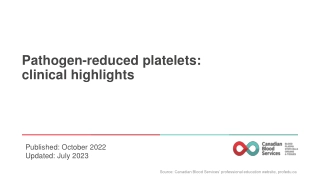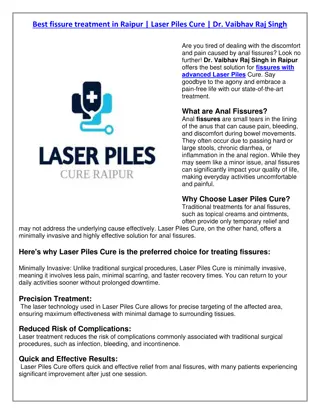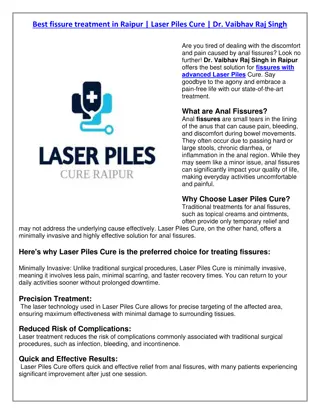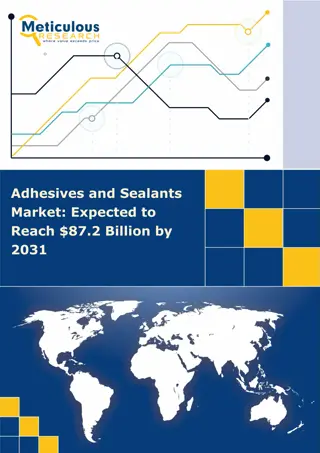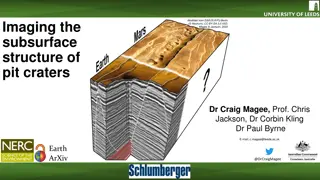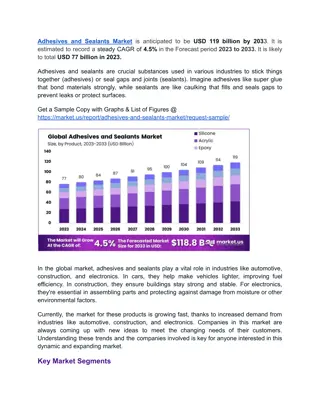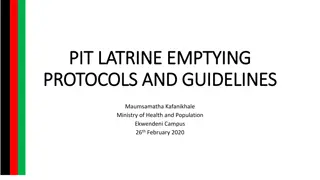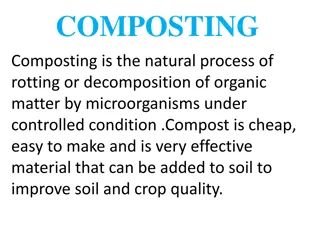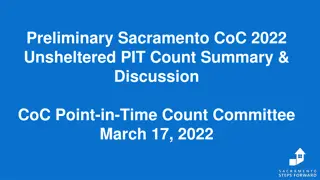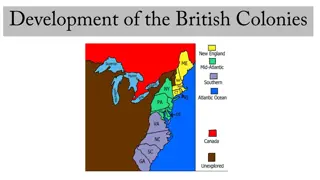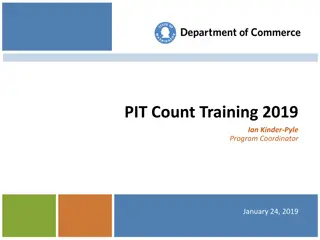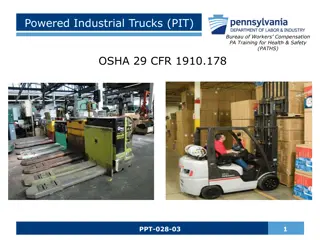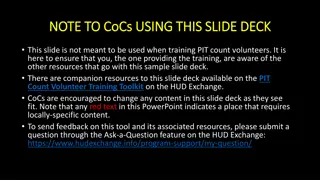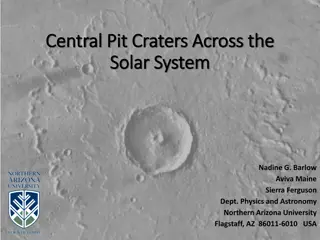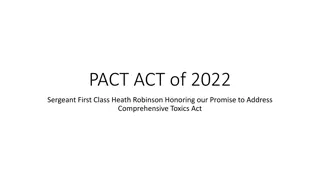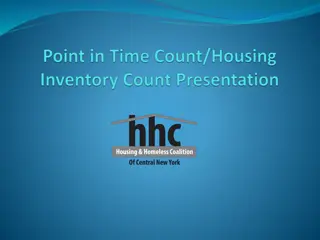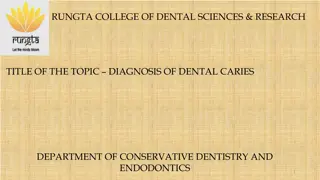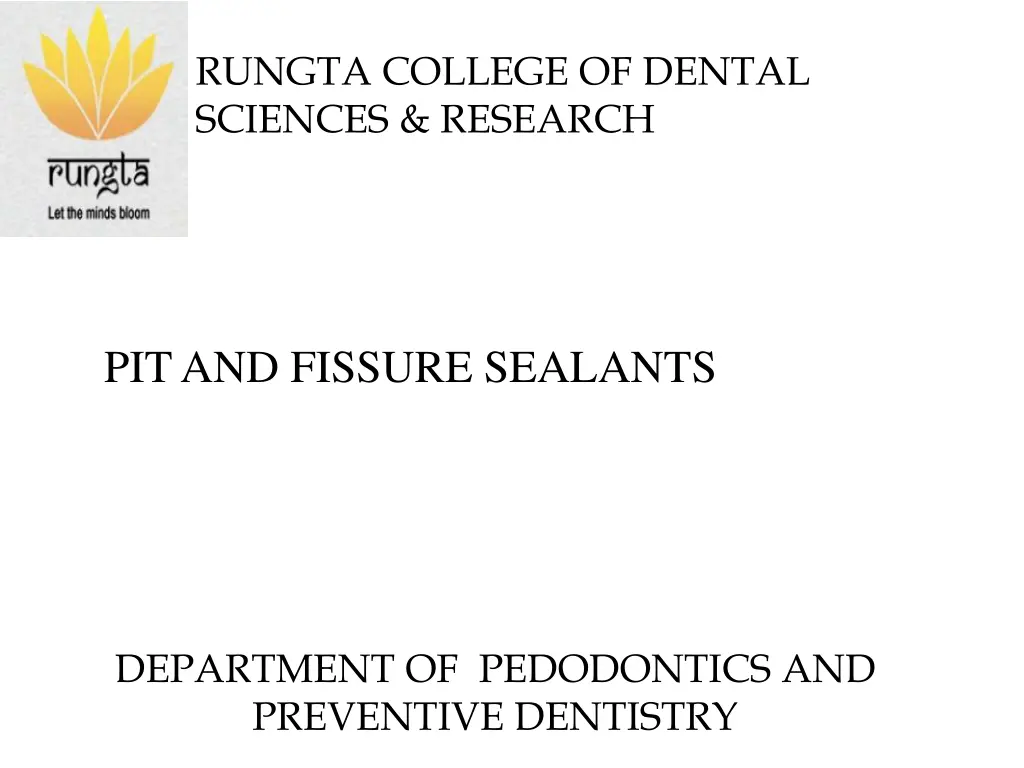
Pit and Fissure Sealants: Evolution, Definitions, and Techniques
Explore the evolution, definitions, preventive techniques, and applications of pit and fissure sealants in dentistry, highlighting the importance of sealant use in preventing and treating caries. Discover the latest advancements and clinical considerations in this field.
Download Presentation

Please find below an Image/Link to download the presentation.
The content on the website is provided AS IS for your information and personal use only. It may not be sold, licensed, or shared on other websites without obtaining consent from the author. If you encounter any issues during the download, it is possible that the publisher has removed the file from their server.
You are allowed to download the files provided on this website for personal or commercial use, subject to the condition that they are used lawfully. All files are the property of their respective owners.
The content on the website is provided AS IS for your information and personal use only. It may not be sold, licensed, or shared on other websites without obtaining consent from the author.
E N D
Presentation Transcript
RUNGTA COLLEGE OF DENTAL SCIENCES & RESEARCH PIT AND FISSURE SEALANTS DEPARTMENT OF PEDODONTICS AND PREVENTIVE DENTISTRY
Specific learning Objectives Core areas Domain DEFINITIONS TYPES/MORPHOLOGY OF FISSURES PREVENTIVE TECHNIQUES FOR CARIES OF OCC SURFACES HISTOPATHOLOGY OF CARIES IN PF TECHNIQUE FOR SEALANT APPLICATION CLASSIFICATION MATERIALS USED AS PFS CLINICAL PROBLEMS WITH SEALANT USE RATIONALE FOR USE OF PFS PRR INDICATIONS RECENT ADVANCES CONTRAINDICATIONS Pit and fissure sealants
Category Types of pit and fissure sealants Pit and fissure usage Morphology of pit and fissure MUST TO KNOW Fissure sealant cycle Clinical technique for placement of pit and fissure sealant NEED TO KNOW DESIRE TO KNOW Current status of pit and fissure sealant Pit and fissure sealants
CONTENTS ; INTRODUCTION EVOLUTION OF PFS DEFINITIONS PREVENTIVE TECHNIQUES FOR CARIES OF OCC SURFACES MICROFLORA OF PF CLASSIFICATION MATERIALS USED AS PFS RATIONALE FOR USE OF PFS INDICATIONS Pit and fissure sealants
CONTRAINDICATIONS REQUIREMENTS OF OCC SEALANTS TYPES/MORPHOLOGY OF FISSURES HISTOPATHOLOGY OF CARIES IN PF TECHNIQUE FOR SEALANT APPLICATION CLINICAL PROBLEMS WITH SEALANT USE PRR RECENT ADVANCES CONCLUSION Pit and fissure sealants REFERENCES
I N T R O D U C T I O abb09 Pit and fissure sealants N
EVOLUTION OF PIT AND FISSURE SEALANTS 1976- first colored sealant- CONCISE WHITE SEALANT (3M dental products) 1984- Burt reported- first and second molars should be sealed as soon as possible after eruption because of their susceptibility to occlusal caries 1989- Eccles noted- fissure sealant should be used preventively for caries prone patient, and therapeutically for suspect or early carious lesion Pit and fissure sealants
DEFINITIONS: Pit: is defined as small pin point depression located at the junction of developmental grooves or at terminals of those grooves. Fissure: is defined as deep clefts between adjoining cusps. They provide areas for retention of caries producing agents. Pit and Fissure Sealant: is used to describe a material that is introduced into the occlusal pit and fissure of caries susceptible teeth, thus forming a micromechanically bonded, protective layer cutting access of caries producing bacteria from their source of nutrients Pit and fissure sealants
MICROFLORA OF PIT AND FISSURES Cocci constitute 75% to 95% of microorganisms S.Sanguis Predominant viable microorganisms S.Mutans and Lactobacilli low in newly formed plaque in fissures over time Fusiforms, Spirillae and Spirochetes are absent Pit and fissure sealants
CLASSIFICATION OF SEALANTS BASED ON GENERATION A. First generation sealants: - polymerized by UV-light at a wavelength 356 m. - disad.: -Excessive absorption and incomplete polymerization of sealant at its depth. - variable output intensity - output not uniform B. Second generation Sealants/Self curing resins - Based on catalyst accelerator system - Most are unfilled. - May be transparent, tinted or opaque by inclusion of white pigment or a tint for better visualization. eg . Concise [3M] white sealant system, Delton. Pit and fissure sealants
C.Third generation sealants: -Light cured by visible light at wavelength 430 nm-490nm. - May be classified as filled or unfilled, and with or with out tint or opaquer. -Most of the unfilled resins are colored white. -Filled resins are either clear, yellowish white or tan PERFORM BETTER THAN SELF CURE RESINS D.Fourth generation sealants: -Are those containing fluorides. Pit and fissure sealants
BASED ON FILLER CONTENT: 1. Unfilled [ free of fillers ] -flow is better -retention is more -abrade rapidly eg . Concise White 2. Filled - need for occlusal adjustments - more resistant to wear eg. Prisma shield Pit and fissure sealants
BASED ON TRANSLUCENCY : 1. CLEAR -Esthetic, but difficult to detect at recall examination. -Better flow than tinted or opaque -More easily appreciated by the patient. 2. TINTED / OPAQUE - can be easily identified COLOURED -easy to see during placement -easy to see during recall check up Pit and fissure sealants
BASED ON CURING: 1. AUTOPOLYMERIZING . - Better retention 88% - Sets by exothermic reaction 2. LIGHT CURE - 75% retentive Pit and fissure sealants
INDICATIONS : RISK-BASED SEALANT TREATMENT Possibility of adequate isolation Questionable enamel caries in PF Xerostomia Patients undergoing orthodontic treatment Deep pits and fissures dthumb3.jpg (24280 bytes) Pit and fissure sealants
CONTRAINDICATIONS ; Posterior teeth that have shallow or well coalesced fissures Low caries risk (PF that remained caries free > 4 yrs) Rampant caries Teeth with proximal decay or occlusal caries involving dentine Allergy to methacrylate Semi-erupted teeth Pit and fissure sealants
TYPES OF OCCLUSAL FISSURES: V Wide at top and gradually narrowing towards the bottom (34%) U Almost same width from top to bottom (14%) IK Hourglass, extremely narrow slit associated with a large space at the bottom (26%). Inverted Y, bifurcating at the bottom (7%). I Extremely narrow slit (19%). Pit and fissure sealants
TECHNIQUE FOR SEALANT APPLICATION PREPARATION OF TOOTH ISOLATION DRYING THE TOOTH ETCHING OF TOOTH SURFACE RINSING AND DRYING OF TOOTH PLACEMENT AND POLYMERIZATION OF SEALANT OCCLUSAL EVALUATION Pit and fissure sealants
TECH. FOR SEALANT APPLICATION Washing and drying : REMOVE ALL ACID AND REACTIONARY PRECIPITATES Rinse with water for 10-20 seconds and dried for additional 10 sec Water under pressure in air-water spray + high power evacuation Evacuator tip placed above/adjacent the tooth and water directed to the tip 20 sec/tooth OR 30 sec/quadrant Pit and fissure sealants
TECH. FOR SEALANT APPLICATION Sealant application -- Sealant applied with disposable bristle brush For autopolymerizing resins cover etched areas on each tooth as quickly as possible with sealant and then bulk can be added For light curing resins no mixing necessary and hence reduced bubbles Sealant applied should be too much thick THUS TOTAL TIME FOR SEALANT APPLICATION SHOULD TAKE 3 MIN Pit and fissure sealants
TECH. FOR SEALANT APPLICATION Adjustment and recall Surface wiped off to remove surface film inspection of surface Occlusion checked with articulating papers Occlusal interferences removed Filled sealants adjusted with green stone Sealants should be evaluated every 6 mnths Bite-wing RG: detect caries progression under sealants Pit and fissure sealants
CHILDREN 1.LOW RISK RISK FACTORS No new/incipient caries in past year Good oral hygiene Regular dental visits One new, incipient/recurrent caries in past year Deep PF High familial caries experience Early childhood caries Frequent sugar exposure Decreased salivary flow Compromised oral hygiene Irregular dental visits Inadequate fluoride exposure Two or more new or recurrent carious lesions in past year Deep PF Sibling or parents with high caries rate History of pit and fissure caries Early childhood caries Frequent sugar exposures Decreased salivary flow 2.MODERATE RISK 3.HIGH RISK Pit and fissure sealants
PREVENTIVE RESIN RESTORATIONS (PRR) FISSURE SEALANT OR SEALANT RESTORATION It is a natural extension of Pit and Fissure sealants. INDICATIONS Tooth can be isolated. No, or only minimal pit and fissure staining Minimal catches in the grooves, or areas with distinct incipient enamel caries. No evidence of radiographic caries. Pit and fissure sealants
TYPE OF SEALANT RESTORATION 1. Sealant alone INDICATIONS Decalcified fissure No RG involvement of dentin Less than 2 other carious lesions in mouth More than 2 other carious lesions in mouth Lesion confined to dentin Cavity in dentin but confined Margins not in occlusal contact Lesion in dentin and lateral spread along DEJ Cavity margins in occlusal contact Large radiolucency in dentin Significant lateral spread of caries 2. Composite + Sealant 3. GIC + Sealant 4. Laminate restoration 5. Amalgam restoration Pit and fissure sealants
RECENT ADVANCES : Use of surfactant containing etchant lower surface tension and contact angle Use of argon laser for polymerization Use of Er: YAG laser Carbon dioxide conditioning Use of DIAGNOdent detection of caries under pit and fissures Pit and fissure sealants
Take Away Home Message Pit and fissure sealant Nuva seal developed and commercially introduced by LD Caulk company in 1971 Fissure types include V,U,I,IK inverted Y more prone to caries. Clear pit and fissure sealant- Helioseal Coloured pit and fissured sealant-CLINPRO Pit and fissure sealants
REFERENCES Fundamentals of paediatric dent.- R.MATHEWSON Dentistry for child and adolescent Mc DONALD Pediatric dentistry STEWART Textbook of pedodontics SHOBHA TANDON Pediatric dentistry: infancy through adolescence- PINKHAM T.B of pediatric dent. BRAHAM MORRIS Cariology NEWBRUN (pediatric dentistry 2002) Pit and fissure sealants: review of literature Pit and fissure sealants

